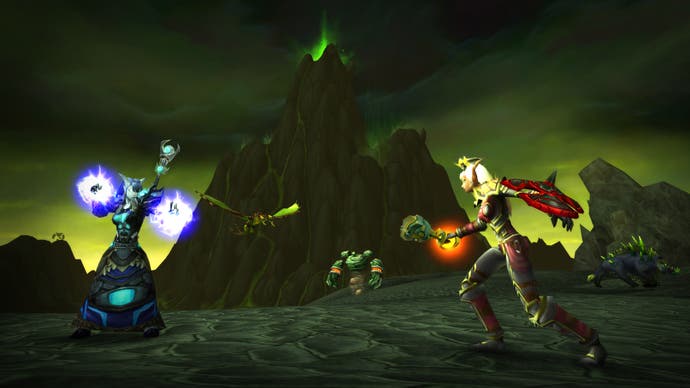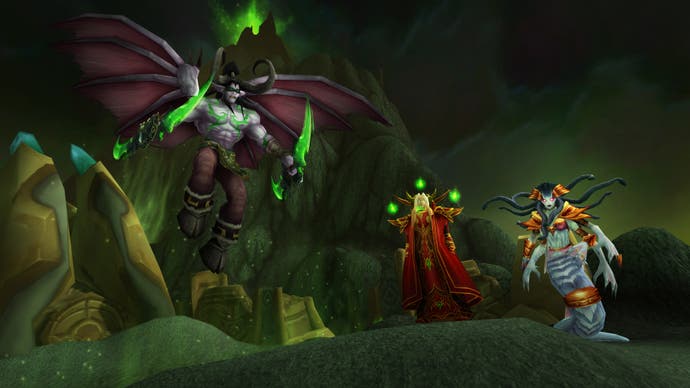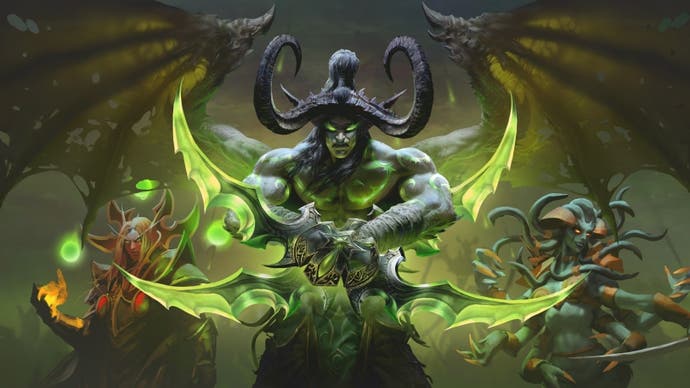Was Burning Crusade World of Warcraft's greatest expansion?
As Outland comes to WOW Classic, we look back with Blizzard on a defining moment.
You can point to many moments from World of Warcraft's early history that define, comment on, or cement its status as the biggest game in the world at the time and a potent pop-cultural force. Its success was both immediate and gradual, which is to say that it launched big and then got bigger, at a rapid rate, for years. Its peak audience size didn't come until late 2010, six years on from its launch, but it was in the first three or four years that it seemed to loom largest in the culture.
One moment that sticks out for me was the launch of first expansion, The Burning Crusade, in January 2007. I remember covering the midnight launch at HMV in London's Oxford Street and being gobsmacked by the size and fervour of the crowd. This was something of the scale of a console launch - beyond it, frankly - only for an expansion pack for an online game. Not only were people there in huge numbers, but there was a specificity, an emotional tenor to their ardour that I would see on an even grander scale at BlizzCon later that year - something more tribal, more communal than the excitement of the console fans. These people belonged.
In a masterstroke of dramatic staging that must have been cursed by the studio's network engineers, Blizzard also gave the launch an in-game focal point with the opening of the Dark Portal, which saw players gather ready to step through the dread gate and enter a shattered new world. It broke the servers, of course, but even that became part of the story. Even while watching the login queues tick down, you knew you were participating in something huge.
What awaited on the other side of that Portal was a stark shift from the (mostly) trad-fantasy trappings of original WOW. Outland, a broken continent floating in a lurid void, introduced a cosmic, surreal strain to Warcraft's already kitchen-sink fantasy. A daunting feature list included two new playable races, new crafting professions and the power of flight, as well as 10 arduous levels of progression, a whole new form of player-versus-player competition in Arenas and probably the most fearsome raiding endgame WOW has ever fielded.
Today, Blizzard turns back the clock to that moment with the release of Burning Crusade Classic, an extension of its popular WOW Classic retro option, included as part of every WOW subscription. WOW Classic production director Patrick Dawson was there at the time - he'd joined the WOW team about a year after the launch of the game - so this is a moment of déjà vu for him as both developer and player. I talked to Dawson alongside lead producer Holly Longdale earlier this year at the reveal of Burning Crusade Classic, and caught up with Dawson again more recently, to talk about what made Burning Crusade a landmark in online gaming.
"You know, being WOW's first expansion, the amount of features and content that was added was unprecedented," Dawson remembers. For him as a player, though, it was all about the raids. "For me, it has some of WOW's most iconic and memorable fights,whether it be Lady Vashj and all the macros you had to make for that, or Illidan, just the difficulty and complexity of that fight. I mean, Kael'thas! It's when my guild first formed... It has lasted since then and we've got 1000 members today. So, to me, that was that moment of me committing to that raiding life, that WOW immersion that so many of us fondly remember."
Some still hold that Burning Crusade was the pinnacle of raiding in WOW, with the 40-player requirement still in place, some of the most involved boss design the game has ever seen, and memorable antagonists with strong links to the themes and story of the wider expansion. The social organisation of raiding was much more challenging and the gameplay was slower and more exploratory, with a greater expectation of failure. "It's really a dedicated, like, almost puzzle solving type thing with a large group," Dawson says. "The thing I've learned as a raid leader is that it's not just about knowing what the boss can do, but it's knowing what the people around you are going to do when the boss does its thing... you have to practice a little bit and get to know them and how they're going to react to those abilities and mechanics."

Longdale's recollection of the expansion was very different, though, as dictated by her playstyle. "I'm the adventurer-explorer archetype. And I was a bit of a lore nerd, so to have Draenei and, I'll be honest, Blood Elves for Horde - the first really pretty female race for Horde - it allowed me to sort of get immersed into Horde. And every environment... I just ran around, and from Blade's Edge to Zangarmarsh to Netherstorm, each environment was a world unto itself. And that to me is what WOW is about - just getting fully immersed in this incredible fantasy world."
I wondered if the team ever considered it a risk to take the game, in its first expansion, so far outside the comforting, if exaggerated, pop-fantasy archetypes of the world of Azeroth. The answer is a sort of qualified "not really"; Blizzard takes pains to make sure there is something grounded and interlinked about even its wildest flights of fancy, and Outland was no different. If it's in the lore, you can do it - and Warcraft lore allows for a hell of a lot.
"The core of Warcraft, lore and story, is strong," says Dawson. And I think that's what keeps it grounded for us, right - like, Outland is a place that has existed in Warcraft lore for a while, it's the home planet of the orcs, it's where they come from. So getting to go through that Dark Portal and see what their homeland was like, although it has been torn asunder, is something that a lot of people wanted to explore with the story... There's all these characters that have existed for all this time. Shoot, you meet Kadghar in Shattrath for the first time in Burning Crusade, that's a pretty major character in WOW history."
"I wasn't working at Blizzard when I was playing Burning Crusade the first time around," says Longdale. "I can say from the point of view of a player, it felt mastercrafted, everything felt relatable." Sometimes even the silliest elements can be the ones to keep players from becoming untethered in a free-floating miasma of fantasy concepts. "Like, you can be in Netherstorm, then all of a sudden you come upon Area 52," - a Goblin encampment with strong pulp sci-fi overtones - "which is just bananas, but it's all relatable. That's sort of the grounding that keeps you in the space and living the story instead of, you know, completely disparate themes that you feel are beyond you. There's always something there to kind of keep you engaged in the story at your level, so you continue to feel important in this completely epic environment."

The Burning Crusade set a template for WOW that has persisted ever since: monolithic, continent-sized expansions, delivered two years apart, interspersed with smaller but still significant content updates to keep players interested during the long waits. It's a formidable schedule from a production perspective, but it's vital to the game's continuing health almost 17 years in. I asked about cut features and Dawson couldn't remember any of note; any good ideas would inevitably turn up in a later content patch or expansion. World of Warcraft's success has never been about leaving things out. It's been about putting them in, and hang the excess. It's maximalist game-making.
A case in point is the flying mounts introduced in Burning Crusade. They have been controversial ever since, with their potential to break immersion and encourage ruthlessly optimised play; the power of flight has been removed from players every expansion to insure the integrity of the questing experience, only to be restored in a later content patch. Did the team foresee or worry about any of this? Again, not really. "It was such a cool feature. We just were excited about it," says Dawson simply. "At the time, we weren't thinking, hey, in a decade, is this [going to be] a good idea? It was: this is cool. Let's do it."
Introduce new features to an online community and you will often get unexpected consequences. This was the case with Arenas, a new PvP mode born from the desire to nurture more focused competitive play for smaller teams - but without the expectation that it would actually become an esport in its own right, a game-within-a-game, as it did. "It was the first time we really got an opportunity to do a little better matchmaking," Dawson says, allowing players to form tight-knit, "tactical, surgical" teams that could find their own level away from the more chaotic Battlegrounds.
Arenas were simple to design but complex to implement. There was the networking challenge, which linked all of WOW's "Battlegroups" - groups of 10 to 12 servers that would play Battlegrounds together - into a single matchmaking pool for the first time. Arenas' two- and three-player teams also asked big questions of WOW's class design and necessitated major rebalancing to embrace as many classes, combinations and specialisations as possible. "World of Warcraft, from its genesis and inception was always balanced and designed as a PvE first game, and that really changed in Burning Crusade," Dawson said. "Once Arenas came out, and we realized how popular they were, we definitely took a look at classes to make sure that we could develop a game that was balanced both in PvP and in PvE. And that is a big challenge, especially when you're looking at 10 classes and multiple specs. The possibilities are pretty infinite, really. So trying to get a game that's balanced that way really was a multiplicative challenge for our systems and class design teams. But they took it well, and we ended up having amazing raids and amazing arenas, which is just a triumph for the team."

Behind this was an even deeper attempt to be less reactive in tuning the classes, and to try to make every class and every spec viable and fun to play. "Like, I remember back in Classic, if you were a Druid and you weren't healing, you probably weren't considered to be on par with those who were. And there wasn't really the concept of people tanking that weren't just Warriors, right? So we really doubled down on that in Burning Crusade to try to give every class the ability to contribute to the raid in some way, shape or form. And that really spurred a lot of the spec fantasy that you see today.
"You know, Paladin tanking was something that really came on strong. Even Shadow Priests, like, that was an interesting rendition of them - they returned mana back then, so they almost healed blue bars, as one of my friends would say. There was a lot of class interplay; you would get Warlocks that were doing shadow damage that would get buffed by the Shadow Priests that were putting shadow debuffs on the creature, or Mages with scorch would create a stack for fire to just do more damage. There was a lot of that type of class intermingling and interplay in there. The concept was, we wanted you to be able to play any class, any spec and be viable and productive in a raid or PvP environment, and Burning Crusade was the first time we really doubled down on something like that. And that's been a great philosophy since then."
The Burning Crusade was a big bet. It took a sprawling, multifaceted beast of a massively multiplayer game and, in many ways, exploded it. In terms of its art and storyline, its concepts, its features and its gameplay tuning, Blizzard didn't hold back. When it comes to the greatest WOW expansions, everyone is bound to have their favourites; personally I think the strongest cases can be made for 2008's Wrath of the Lich King and, more recently, 2016's Legion. But Burning Crusade was unquestionably the most ambitious, possibly the most fearless, and inevitably the most influential on what WOW would become. "It was quite a risk for the team," says Dawson. "But boy, are we glad we took that risk. It was such an amazing expansion."


